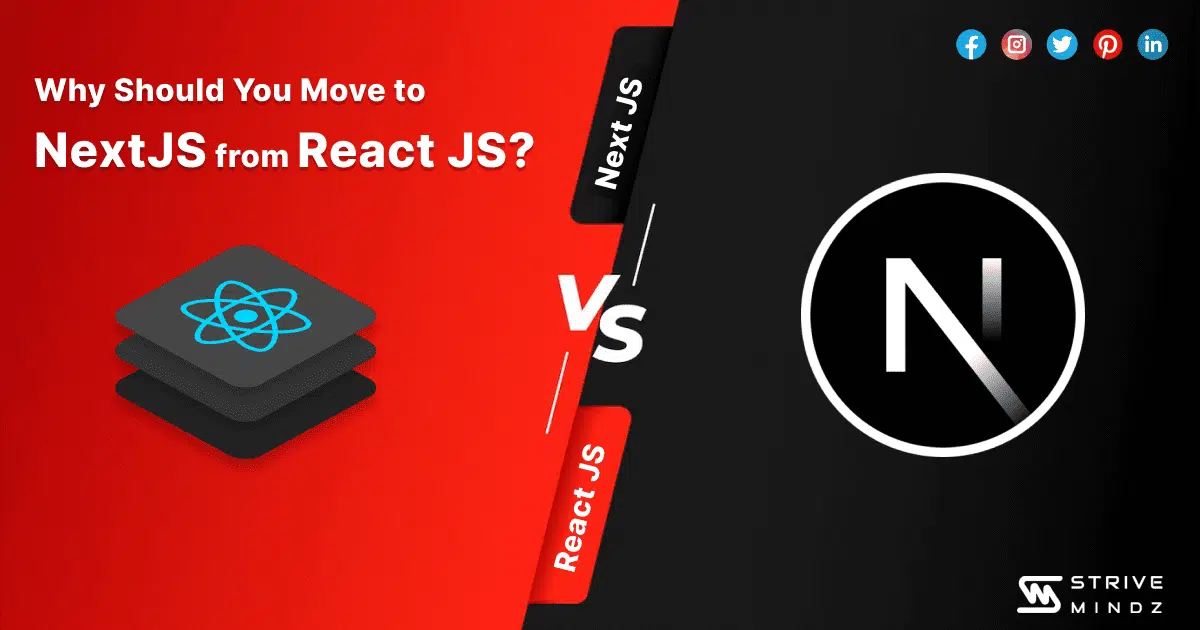NextJS vs React JS: Why should you move to NextJS from React JS?

In this post, we compare NextJS vs React JS and why you should move to Next JS. It is important to decide the platform you are going to work on before stepping into the world of programming and development. Changing trends and work profiles in the industry has resulted into a wave of change in the technological development as well. With the launch of several development platforms and programming languages, the confusion amongst the developers has increased as well.
React is an open-source, front-end, JavaScript Library created and handled by Facebook. It is generally used as a base in the development of single-page or mobile applications. However, React Js is only concerned with state management and rendering that state to DOM, so creating React applications usually requires the use of the additional libraries for routing, as well as certain client-side functionality.
Next JS gives the best developing experience with all the features that are important for production of a web or mobile application. Next JS is a framework created by Vercel. It is based on Node.js and Babel. It is quite similar to React for developing single-page apps.
Next JS supports static export, pre-rendering and has many more nice features like automatic building size optimization, faster developer compilation and a preview mode.
Why to choose Next JS over React JS?
React is a powerful tool when used with stream templating libraries. For building dynamic web applications React JS can be a very good choice. But due to constant change in technologies with React JS it is very difficult to create a proper documentation.
If the experience of a developer while building a website or application is taken into consideration, they would choose Next JS over React JS in a heartbeat. This change in trend is because of the libraries and frameworks provided by Next JS. Next JS is constantly growing which means it will be maintained for a long time. With Next JS, developers can leverage React to support server-side rendering (SSR). Given below are a few important points that suggest why it is important to switch to Next JS:
-
Next JS vs React JS: Speed and Easiness of Coding
Creating pages for React JS project is little typical as here you’ll have to create a component and then add it to the router, to get the access. Whereas in Next JS, you can easily create pages for your project by adding the page to the page folder and the necessary header component link.
With Next JS, the developer will have to write less code and there is possibility that your project is easy to understand and access.
-
Next JS vs React JS: Performance
According to stats apps built with Next JS are comparatively faster than the ones built with React JS. It is necessary to build an app that works faster and effectively for your customers. Next JS has certain features like image optimization, internationalization and incremental static that helps developer in building effective applications.
Though React JS supports client-rendering, it is not enough when you work with a large customer base. In order to deal with a huge customer base, one must build a high-performance application, which is not possible with React JS.
-
Next JS vs React JS: Features
As Next JS is built over React JS, it takes advantage of React JS to help developers build single-page apps. A few common Next JS features are:
-
Server-Side Rendering (SSR)
SSR is used to fetch data and pre-populate a page with custom content. It makes navigation easier and faster for users. Each request of fetching data is taken and delivered in HTML. This improves page loading time and makes it easily accessible.
-
Static export (SSG)
Next JS is a combination of both SSR and SSG that means it with it we can build websites that render at build time. SSG file directly means having faster website.
-
SEO optimization
Because of the use of both SSR and SSG, Next JS can improve SEO of a website exponentially, giving a boost to the website.
-
Optimized bundling and code splitting
It is a general fact that building an application with split code increases the functioning of the application. Since the code written in Next JS is lightweight, it is easy to split it into smaller sections. Therefore, the code is uploaded in optimized bundles and not in bulk.
With React JS you can include features like routing as well as state management patterns with libraries like Redux. Instead of using Redux, NextJS uses data fetching APIs that allows pre-rendering.
-
Next JS vs React JS: Documentation
In addition to the boring and dry documentation on some framework home pages, before working with React or Next JS, it is important to take additional courses, books, tutorials and articles to get started.
Both React JS and Next JS have good documentation. It is crucial to have good documentation for every software, for proper understanding of tools and libraries. Next JS has a learn-by-doing documentation set that guides user through each and every detail of the development, routing and component creation.
-
NextJS vs React JS: Community
The support developers and programmers aim to achieve from their fellow community is very crucial in the growth of each individual present in the community. The community also includes YouTube videos, blog posts and other form of tutorials. For both NextJS and React JS, the development community is active and supportive. React JS has been in the market for longer period of time and over time the React community has increased and reached heights.
On the other hand, Next JS has gained immense popularity in few years of its launch. There are several blog posts, tutorials and videos available on the internet for Next JS that makes it easier to learn and solve your doubts. Several online platforms such as GitHub has vast libraries and resources for learning Next JS.
-
NextJS vs React JS: Cost of Development
NextJS and React JS both are open-source development platform, which basically means there is low to zero cost of development. React JS has been in industry for quite a time now, so finding developer for the development of React JS is comparatively easier than finding a good developer for Nest JS.
But the time is changing, NextJS is finally getting the deserved recognition in the industry and companies are understanding its potential. Shifting from React JS to Next JS would not cost a lot of money. You just have to find experienced, dedicated and determined developers, who can devote enough time to make the whole shifting process easier and smoother.
Benefits of NextJS
Next JS is gaining popularity and recognition incredibly fast rate in this generation of technology. Apps developed on this platform are high-speed and server-side rendering, which makes it reliable and easily accessible.
In its efforts to make React apps deployment as simple as possible, Vercel the company behind Next JS, sought to simplify the process by making deployment just a few clicks away. There are many reasons to use Next JS as your development platform or migrating to Next JS from React JS including the following:
-
Increasing traffic
If you are looking to have an online store in near future, trust us when we say, Next JS is the best platform for you. It provides the perfect optimization and gives you the competitive edge that is important to establish your business. In order to increase organic traffic for your webstore, Next JS is the best platform.
-
To create a landing page
Next JS is generally used for creating landing pages or other marketing-focused pages because of its high-speed and static site creation features. NextJS is very popular amongst the marketers because of its usability and accessibility.
-
Creating an online eCommerce store
Next JS recently released a powerful e-commerce starter kit that allows you to build high-performing, google-friendly, and user-friendly online stores.
-
Creating marketing websites
By displaying the application on the server, the load time can be significantly reduced. Especially in the cases where visitor’s device is slow. This is one of the major perks of using Next JS.
Conclusion
Both React JS and NextJS provides great opportunities for developers in their own ways. It is dependent on your requirements and needs. React JS allows to build things the way developer wants to and Next JS simplifies the task and makes it easier for the developer to create or migrate any app/website to Next JS. The tools and conventions available with Next JS make it a lot more accessible for users.
We have tried our best to provide you with all the comparison between NextJS vs React JS. We strongly recommend you to shift from React JS to NextJS, but it is all up to you and your needs. You can learn more about Next JS from the communities on YouTube or other platforms. If you have any query or suggestions for us, feel free to reach out to us through our email id or mobile number.
